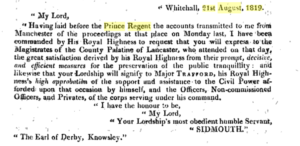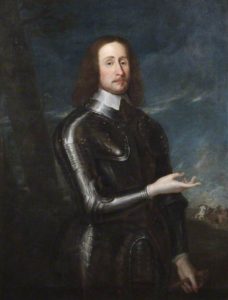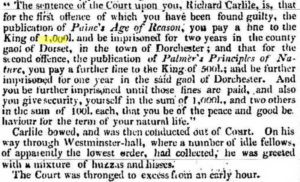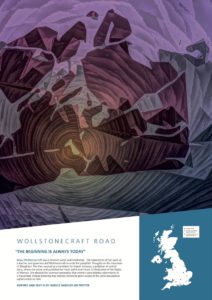With the 200th anniversary of The Peterloo Massacre in 2019 and the release of the new Mike Leigh film on November 9th, a look at its connections and aftermath via the county of Dorset would seem most fitting. The Clubmen movements of 1645 in Dorset were a direct reaction against Parliamentarian and Royalist armies. With troops from both sides garrisoned and passing through the County the generality in that County rallied against what was seen as a forced hand and to side with and choose a side for a quarrel of not their making. A rejection of a quarrel that was seen as most unnatural.
Jumping to the 19th Century it is of note that the keeping of and stationed of Yeomanry in Dorset was met with resistance and forced to disband twice in 1802 and 1814 . Seen as a wartime force with state interests at heart, anti rebellion and the power in a foreign invasion in driving out food stock and clearing of land.
The decedents of those Clubmen of past had a long memory of such matters. A report from the York Assizes [By Express.] regarding the aftermath of Peterloo, has an uncanny similarity in wording and in spirit of the Clubmen petitions of 1645.
M r. Justice Bayley and a Special Jury, The King V. Hunt And Others.
“Much had been said respecting this subject upon the right of the people to assemble in large bodies, and upon what constituted a legal meeting. The people of England had an undoubted right to meet for the purpose of considering public grievances, and seeking lawful redress for any evils they endured. It had long been the practice for cities, counties, towns, corporations, districts, and trades to meet to consider matters relating to their affairs. It had long been the practice of the Constitution to hold such meetings, and to receive petitions from them on the Throne, or in either House of Parliament”
The yeomanry actions and a link of note in Dorset to the Peterloo Massacre of 16 August 1819 consists in a letter also. Penned by Prince Rupert’s personal secretary, Sir Basil Bloomfield. Prince Regent was in Dorset anchored off Christchurch on his yacht the Royal George. Not considering any reports from that day he had approved and sent his congratulations to the Manchester Hussars and Magistrates for their actions that day. Now was this letter and its authenticity really penned from the Prince Regents secretary or can it be more ascribed to Lord Sidmouth and Castlereagh? As noted the Prince was in his yacht 300 miles from the events that day in Manchester.

The defense after of those who acted that day in the massacre by the executive and the Prince defending and rebuking any suggestion of his letters authenticity ,confirmed the Prince stance on the wording and intention of the letter .
Another link associated was to occur later in the writings of the poet Percy Shelley and his poem Mask of Anarchy. The poem written in anger after hearing of news of the Peterloo Massacre was also a personal attack on Foreign Secretary, Castlereagh and the Home Secretary, Lord Sidmouth. Percy Shelley’s heart is buried in Bournemouth. The family tomb we will speak of later.
Mary Shelley wife of Percy Shelley and the author of Frankenstein would also in be drawn into a link with Peterloo and Bournemouth in Dorset.
The organisation behind the public meeting calling for political reform in Manchester on the 16th August 1819 went by the name the Patriotic Union Society. This body of reformers calling for constitutional reform stemmed from what was once members belonging to the Lancashire branch of the Hampden Club.
The Hampden Club was an organisation formed which campaigned for parliamentary reform and was named after John Hampden, the English Revolution Parliamentary leader.

Hampden was a central figure in the Civil War. His refusal to pay and opponent of ship money was an indicator of the divides growing between Parliament and King Charles. Hampden was also a keen supporter of the Grand Remonstrance, summarising all of Parliament’s grievances to Charles’ foreign, financial, legal and religious policies.
The publication of Frankenstein in 1818 saw reference to John Hampden within its pages and shows an admiration for Hampden.
With Victor Frankenstein and Henry Clerval prolonging their stay in Oxford.
“We visited the tomb of the illustrious Hampden, and the field on which that patriot fell. For a moment my soul was elevated from its debasing and miserable fears, to contemplate the divine ideas of liberty and self-sacrifice, of which these sights were the monuments and the remembrancers. For an instant I dared to shake off my chains, and look around me with a free and lofty spirit; but the iron had eaten into my flesh, and I sank again, trembling and hopeless, into my miserable self”.
Mary Shelley herself and her father Godwin visited John Hampdens grave in October 1817.
A connection also with the English Revolution and with Dorset, which we will come to later as regards to Mary Shelley’s Frankenstein manuscripts comes from William Sydenham and Dr Thomas Sydenham.
William from Wynford Eagle Dorset fought on the side of Parliament in the Civil War and was the uncle on Lady Mary Chudleigh the early 17th century poet and writer. Mary born in 1656 argued for reform regarding education and marriage for women and that women had and should influence and cultivate reason and as women faced their own social issues.
Her work The Ladies Defence is an essay in verse written in response to a wedding sermon by 17th century minister John Sprint . The sermon speaks of women being obedient to a husband. Mary Chudleigh’s other uncle was the doctor Thomas Sydenham, well known for his work on epidemic diseases.
Civil War, Frankenstein, Shelley Manor connection with Mary Chudleigh ?
Part of the Percy Shelley and Mary Shelley manuscripts, including the Frankenstein early journals, ended up with his son Percy Florence and his wife Jane in Boscombe near Christchurch in Dorset at Shelley Manor, now a doctors surgery. The manor was bought with the intention of Mary Shelley seeing her later life spent in Boscombe. Sadly Mary died in London before the move.
As we see, the links to John Hampden and the English Revolution with the inclusion in Frankenstein and Mary Shelley’s visit to his grave has many links to others . William and Thomas Sydenham from the English Revolution. One fought on the side of Parliament as did John Hampton and the other became a doctor of note. Shelley Manor once the home of Mary Shelley’s journals is now a doctors surgery and links with Lady Mary Chudleigh and her writings are a stepping stone in the story of women making, writing on and shaping the society and culture. William Sydenham’s son also called William later ended up in Dorset’s Dorchester jail, which was also the fate of Richard Carlile.
The story and direction continues.
Percy Shelley’s poems were also printed in the radical and reform movements publication Sherwin’s Political Register. The radical journal was brought about by Richard Carlile. Carlile an agitator for the establishment of universal suffrage and freedom of the press in the United Kingdom, was due to be speak at Peterloo. When the Yeomanry attacked he escaped and was hid by friends. Catching the mail coach back to London, his eyewitness account of the Peterloo Massacre was published in Sherwin’s Weekly Political Register of 18 August 1819.
Carlile was later brought to trial for blasphemy, blasphemous libel and sedition. His printing of Tom Paine’s Common Sense, The Rights of Man and the Age of Reason resulted in him being jailed and fined in October of1819. The place of his imprisonment was in Dorchester, Dorset. While there he carried on writing for Sherwin’s Political Register now called The Republican which achieved a higher reading public then the newspaper The Times.

Florence Shelley had a memorial placed to Shelley in Christchurch Priory as Bournemouth church St Peter’s, where his heart is buried in the Shelley, Godwin’s, Wollstonecraft family tomb, refused to accept a memorial in the church. (Well it is Bournemouth) .The waters where Prince Regent had been anchored in August 1819 was as mentioned in Christchurch Bay and the imprisonment of Richard Carlile. A full circle of locations, references and the English Revolution to boot, looking at things regards to Prince Regent, Manchester, Peterloo and the Shelley Dorset Christchurch connection.

A project by Digital Artist Jon Adams set up around the Magna Carta anniversary 2015 had in its repertoire a map depicting Wollstonecraft Road in Boscombe. Bringing the Shelley links into the digital 21st century .
Clubmen, Shelley memorial in Christchurch Priory and the Prince Regent theatre in the town and the connections therein with Manchester August 16th 1819.
Haydn Wheeler












